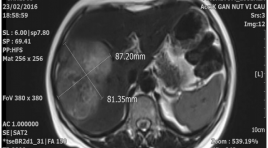
Ứng dụng hình ảnh nhạy từ SWI trên máy SIEMENS ESSENZA – 1.5T tại BVĐK tỉnh Hải Dương
25/08/2021 14:52:53 | 0 binh luận

Ứng dụng cắt lớp vi tnh hai mức năng lượng trong chụp mạch máu ngoại biên
25/08/2021 14:56:18 | 0 binh luận

So sánh vai trò cộng hưởng từ "Khuếch tán theo hướng" và "Dán nhãn spin động mạch" trong phân độ mô học u sao bào
06/05/2021 17:42:48 | 0 binh luận
SUMMARY Objectives: The purpose of this study was to determine the value of DTI and ASL in preoperative predicting the histological grade of astrocytomas. Methods: Retrospective study with 29 patients in Choray Hospital, in 01/2017-12/2019, with histological verified astrocytomas. DTI, ASL were preoperatively performed. Results: The mean age # 42.48 years. The ratio of men/women is 0.93/1. The FA, CBF, rCBF values of LGA were significantly lower than those of HGA (p < 0.05). With a threshold of FA of 0.224, a threshold of rCBF of 3.06 ml/100g/minute, DTI and ASL has the same sensitivity, specificity, PPV, NVP, accuracy of 76.2%, 87.5%, 94.1%, 58.3%, 79.3%. AUC of DTI is 75% and AUC of ASL is 85%. Conclusion: FA and CBF, rCBF values can distinguish between high grade and low grade astrocytomas. Key words: MR diffusion tensor imaging, arterial spin labeling, fractional anisotrophy (FA), cerebral blood flow (CBF), astrocytomas, histological grade.

Đánh giá hiệu quả bước đầu trong điều trị ung thư biểu mô tế bào gan bằng phương pháp nút mạch sử dụng hạt vi cầu phóng xạ YTTRIUM-90
30/03/2020 14:45:16 | 0 binh luận
T he results of Y90 radioembolization in treatment of hepatocellular carcinoma SUMMARY Background : Hepatocellular carcinoma (HCC) is aggressive primary malignancy of the liver that most commonly presents late in the disease course. As a result, the majority of patients are not candidates for curative therapies. Locoregional therapies including Yttrium-90 (Y-90) radioembolization play an important role in management of the vast majority of patients with HCC. Methods : Patients with unnresectable HCC (n=41) treated with Y-90 radioembolization from 2013 to 2016 were evaluated retrospectively. Data was abstracted from medical records including patient charts, laboratory data, and imaging. Results : The most common clinical toxicity among all patients was fatigue (58.5%). A clinical benefit, defined as patients achieving PR was seen in 95.13% of cases; was seen complete reponse (CR) in 4.87%. The mean overall survival from the time of diagnosis was 18.4 months. Conclutions : For patients with HCC, Y-90 radioembolization is a safe and well-tolerated procedure. Our experience suggests that a significant percentage of patients achieve clinical benefit including many with PR. Prospective, randomized data is required to compare radioembolization with other therapies including chemoembolization and systemic therapy with sorafenib. Keywords : Radioembolization, Yttrium-90 microspheres, SIR-spheres, Hepatocellular carcinoma, Transarterial radioembolization, SIRT.

Các tiến bộ kỉ thuật cộng hưởng từ trong hình ảnh u não và ứng dụng tại bệnh viện Chợ Rẫy
31/03/2020 17:07:38 | 0 binh luận
Advanced MR techniques in brain tumor imaging and the application at Choray hospital SUMMARY MRI is the imaging modality of choice for brain tumours. Advanced MRI techniques have significantly developed and used clinically in imaging of brain tumor such as: diffusion-weighted imaging (DWI), perfusion-weighted imaging (PWI), diffusion-tensor imaging (DTI) and magnetic resonance spectroscopy (MRS). Conventional MR imaging (MRI) provides mainly anatomic or structural information about the brain and tumor. Unlike conventional imaging, advanced MR techniques also provide physiological information concerning tumor cellularity, white matter invasion, metabolism and hemodynamics.These techniques can be used to diagnosis, differential diagnosis, grading, surgical planning, and monitoring of therapeutic response of brain tumors. A principles of the physiology, techniques, and clinical applications of these techniques is provived. Some experience of using these technique in the domain of brain tumor at Choray Hospital were also presented in this article. Key words: Advanced MR techniques, brain tumor, diffusion-weighted imaging (DWI), perfusion-weighted imaging (PWI), diffusion-tensor imaging (DTI) and magnetic resonance spectroscopy (MRS), conventional MRI.
Bạn Đọc Quan tâm
Sự kiện sắp diễn ra
Thông tin đào tạo
- Những cạm bẫy trong CĐHA vú và vai trò của trí tuệ nhân tạo
- Hội thảo trực tuyến "Cắt lớp vi tính đếm Photon: từ lý thuyết tới thực tiễn lâm sàng”
- CHƯƠNG TRÌNH ĐÀO TẠO LIÊN TỤC VỀ HÌNH ẢNH HỌC THẦN KINH: BÀI 3: U não trong trục
- Danh sách học viên đạt chứng chỉ CME khóa học "Cập nhật RSNA 2021: Công nghệ mới trong Kỷ nguyên mới"
- Danh sách học viên đạt chứng chỉ CME khóa học "Đánh giá chức năng thất phải trên siêu âm đánh dấu mô cơ tim"












